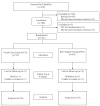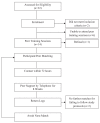Cardiac Home Education and Support Trial (CHEST): a pilot study
- PMID: 19960132
- PMCID: PMC2807834
- DOI: 10.1016/s0828-282x(09)70531-8
Cardiac Home Education and Support Trial (CHEST): a pilot study
Abstract
Background: Coronary artery bypass graft (CABG) surgery is performed more frequently in individuals who are older and sicker than in previous years. Increased patient acuity and reduced hospital length of stays leave individuals ill prepared for their recovery.
Objectives: To test the feasibility of a peer support program and determine indicators of the effects of peer support on recovery outcomes of individuals following CABG surgery.
Methods and results: A pre-post test pilot randomized clinical trial design enrolled men and women undergoing first-time nonemergency CABG surgery at a single site in Ontario. Patients were randomly assigned to either usual care or peer support. Patients allocated to usual care (n=50) received standard preoperative and postoperative education. Patients in the peer support group (n=45) received individualized education and support via telephone from trained cardiac surgery peer volunteers for eight weeks following hospital discharge. Most (93%) peer volunteers believed they were prepared for their role, with 98% of peer volunteers initiating calls within 72 h of the patient's discharge. Peer volunteers made an average of 12 calls, less than 30 min in duration over the eight-week recovery period. Patients were satisfied with their peer support (n=45, 98%). The intervention group reported statistical trends toward improved physical function (physical component score) (t [89]=-1.6; P=0.12) role function (t [93]=-1.9; P=0.06), less pain (t [93]=1.30; P=0.20) and improved cardiac rehabilitation enrollment (chi2=2.50, P=0.11).
Conclusions: These preliminary results suggest that peer support may improve recovery outcomes following CABG. Data from the present pilot trial also indicate that a home-based peer support intervention is feasible and an adequately powered trial should be conducted.
HISTORIQUE :: Le pontage aortocoronarien (PAC) est plus fréquent chez des personnes plus âgées et plus malades que par le passé. Une activité accrue des patients et une hospitalisation moins longue préparent mal les patients à leur rétablissement.
OBJECTIFS :: Utiliser un projet pilote pour évaluer la faisabilité d’un programme d’entraide par les pairs et déterminer les indicateurs des effets de l’entraide par les pairs sur le rétablissement des patients après un PAC.
MÉTHODOLOGIE ET RÉSULTATS :: On a fait participer des hommes et des femmes qui subissaient pour la première fois un PAC non urgent dans un seul établissement de l’Ontario afin de procéder à un essai clinique aléatoire pilote prélivraison. On a réparti aléatoirement les patients entre les soins habituels et l’entraide par les pairs. Les patients recevant les soins habituels (n=50) ont reçu la formation préopératoire et postopératoire habituelle. Les patients du groupe d’entraide par les pairs (n=45) ont reçu une formation et un appui téléphoniques personnalisés de la part de pairs volontaires formés en chirurgie cardiaque pendant huit semaines après le congé hospitalier. La plupart des pairs volontaires (93 %) se sentaient préparés à leur rôle, 98 % d’entre eux ayant amorcé les appels dans les 72 heures suivant le congé du patient. Les pairs volontaires ont fait une moyenne de 12 appels de moins de 30 minutes pendant la période de rétablissement de huit semaines. Les patients étaient satisfaits de cette entraide par les pairs (n=45, 98 %). Le groupe d’intervention a fait état de tendances statistiques vers une meilleure fonction physique (indice d’élément physique) (t [89]= −1,6, P=0,12), une meilleure fonction du rôle (t [93]= −1,9, P=0,06), une diminution de la douleur (t [93]= −1,30, P=0,20) et une augmentation de la participation à la réadaptation cardiaque (χ2=2,50, P=0,11).
CONCLUSIONS :: Ces résultats préliminaires laissent supposer que l’entraide par les pairs peut améliorer le rétablissement après un PAC. Les données du présent projet pilote indiquent également que l’intervention d’entraide par les pairs à domicile est faisable. Un essai d’une portée suffisante devrait être effectué.
Trial registration: ClinicalTrials.gov NCT00275340.
Figures
References
-
- Ghali WA, Quan H, Shrive FM, Hirsch GM. Outcomes after coronary artery bypass graft surgery in Canada: 1992/93 to 2000/01. Can J Cardiol. 2003;19:774–81. - PubMed
-
- Pain after cardiac surgery: An acute and/or chronic problem. APS/CPS Scientific Meeting, 2004; Vancouver. September 6, 2004.
-
- Tranmer JE, Parry MJE. Enhancing postoperative recovery of cardiac surgery patients. A randomized clinical trial of an advanced practice nursing intervention. West J Nurs Res. 2004;26:515–32. - PubMed
-
- Gallagher R, McKinley S, Dracup K. Effects of a telephone counseling intervention on psychosocial adjustment in women following a cardiac event. Heart Lung. 2003;32:79–87. - PubMed
Publication types
MeSH terms
Associated data
Grants and funding
LinkOut - more resources
Full Text Sources
Medical



